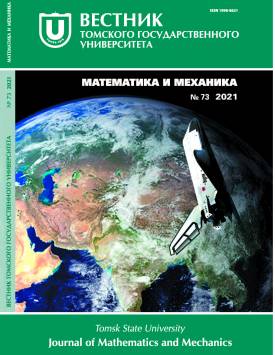Rotations of tori in a liquid crystal structure
Liquid crystals are a collection of flattened molecules. On the one hand, they have a well-defined structure, on the other hand, this structure is deformable, since its elements can change their position in space. In columnar structures, consisting of disks, plates, and tori, the fluid lines and cords are distinguished. In the case of tori and circular disks, a hexagonal structure of the arrangement of molecules is observed in a combination of the cord. The aim of this work is to obtain the stability of tori positions in an elementary fragment of a liquid crystal and to analyze their rotations in a self-consistent field of the surrounding toroidal molecules. To solve this problem, the method of mathematical modeling was used, based on classical models of molecular dynamics. The calculation is carried out on the basis of the model of cross-atom-atom interactions for molecular tori. The minimal fragment of the cord is selected, which makes it possible to determine the characteristic dynamic state of the central torus in the fragment. To describe the motion of the molecular tori, the equations of motion for their centers of mass and the Euler equations for their angular displacements are used. The minimal fragment of the material contains twenty-nine tori. The equations for displacements of the centers of mass of the tori are initially represented as ordinary differential equations of the second order. However, by introducing fictitious points into the consideration of velocities, they can be reduced to a system of first-order equations with a doubled number of lower-order equations. The resulting system of the first-order differential equations is integrated numerically using a high-order accuracy step-by-step scheme. All calculations are performed with a constant time step. The accuracy of the obtained numerical results is verified in terms of the balance of total energy of the system. Calculations show that the central torus of the presented fragment executes angular oscillations around its main axis with amplitude of more than one revolution. Thus, the performed calculations show that a representative fragment of the liquid crystal structure of molecular tori can be used as a generator of high-frequency mechanical vibrations.
Keywords
nanomaterials,
mathematical modeling,
molecular dynamics,
nanotori,
carbon materials,
surface materialsAuthors
| Bubenchikov Aleksey M. | Tomsk State University | bubenchikov_am@mail.ru |
| Bubenchikov Mikhail A. | Tomsk State University | michael121@mail.ru |
| Mamontov Dmitriy V. | Tomsk State University | orevaore@mail.ru |
| Kaparulin Dmitriy S. | Tomsk State University | dsc@phys.tsu.ru |
| Lun-Fu Aleksandr V. | OOO Gazprom Transgaz Tomsk | a.lun-fu@gtt.gazprom.ru |
Всего: 5
References
Chang I.-L., Chou J.-W. A molecular analysis of carbon nanotori formation // Journal of Applied Physics. 2012. V. 112. P. 063523. DOI: 10.1063/1.4754538.
Staic M., Petrescu-Nita A. Symmetry group of two special types of carbon nanotori // Acta Cryst. Section A. Foundations of Cryst. V. 69. P. 435-439. 2013. DOI: 10.1107/S0108767313010325.
Tasci E., Yazgan E., Malcioglu O.B., Erkoq S. Stability of carbon nanotori under head treatment: molecular-dynamics simulations // Fullerenes, Nanotubes and Carbon Nanostructures. 2005. V. 13(2). P. 147-154. DOI: 10.1081/FST-200050695.
Kharissova O.V., Castanon M.G., Kharisov B.I. Inorganic nanorings and nanotori: State of the art. // Journal of Materials Research. 2019. V. 34(24). P. 3998-4010. DOI: 10.1557/ jmr.2019.370.
Loyola M., Santoso E.B., Estrada G. A quotient space approach to model nanotori and determine their symmetry groups // Journal of Applied Physics Conference Proceedings. 2014. V. 1602(1). P. 620-626. DOI: 10.1063/1.4882549.
Chou Y.Y., Guo G.-Y. Electrical conductance of carbon nanotori in contact with single-wall carbon nanotubes // Journal of Applied Physics. 2004. V. 96. P. 2249. DOI: 10.1063/ 1.1766415.
Faraji U.M., Alaeiyan M., Golriz M., Gilani A. Harmonic indices of polyhex zigzag TUZC 6 [m;n] nanotube and nanotori // Journal of Information and Optimization Science. V. 41(4). P. 1-8. 2020. DOI: 10.1080/02522667.2020.1744309.
Sarapat P., Hill J.M., Baowan D. A review of geometry, construction and modelling for carbon nanotori // Appl. Sci. 2019. V. 9(11). P. 2301. DOI: 10.3390/app9112301.
Hilder T.A., Hill J.M. Orbiting atoms and C60 fullerenes inside carbon nanotori // Journal of Applied Physics. 2007. V. 101. P. 064319. DOI: 10.1063/1.2511490.
Dadashev V., Gindulyte A., Lipscomb W.N., Massa L., Squire R.H. Proposed new materials: boron fullerenes, nanotubes, and nanotor // ACS Symposium Series. 2002. P. 79-102. DOI: 10.1021/bk-2002-0827.ch005.
Liu C.P., Chen H.B., Ding J.W. Magnetic response of carbon nanotori: the importance of curvature and disorder // Journal of Physics: Condensed Matter. 2007. V. 20. DOI: 10.1088/0953-8984/20/01/015206.
Low Y., McGuigan M. Visualization and simulation of the material properties of carbon nanotori // New York Scientific Data Summit (NYSDS). 2016. V. 1-4. DOI: 10.1109/NYSDS.2016.7747824.
Liu L., Gui G.Y., Jayanthi C.S., Wu S.Y. Colossal paramagnetic moments in metallic carbon nanotori // Physical Review Letters. 2002. V. 88(21). DOI: 10.1103/PhysRevLett.88.217206.
Bubenchikov A.M., Bubenchikov M.A., Mamontov D.V., Lun-Fu A.V. Md-simulation of fullerene rotations in molecular crystal fullerite // Crystals. 2019. V. 9. Art. 496. DOI: 10.3390/cryst9100496.
Bubenchikov A., Bubenchikov M., Mamontov D. The dynamic state of a pseudo-crystalline structure of B42 molecules // Crystals. 2020. V. 10. Art. 510. DOI: 10.3390/cryst10060510.
Bubenchikov M.A., Bubenchikov A.M., Tarasov E.A., Usenko O.V., Chelnokova A.S. Calculating permeability of the low-temperature phase of a fullerite // Diamond and Related Materials. V. 86. P. 146-180. 2018. DOI: 10.1016/j.diamond.2018.04.017.
Bubenchikov A.M., Bubenchikov M.A., Jambaa S., Lun-Fu A.V., Chelnokova A.S. Low-temperature separation of helium-helion mixture // Rev. on Adv. Materials Science. 2020. V. 59(1). P. 361-370. DOI: 10.1515/rams-2020-0004.

